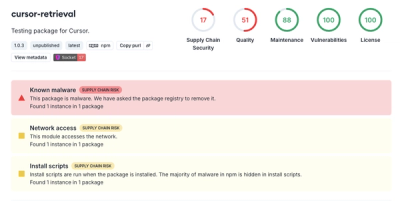
Security News
The Risks of Misguided Research in Supply Chain Security
Snyk's use of malicious npm packages for research raises ethical concerns, highlighting risks in public deployment, data exfiltration, and unauthorized testing.
diff-sequences
Advanced tools
Compare items in two sequences to find a longest common subsequence
The diff-sequences package is a utility for finding the longest common subsequence of items in two sequences (arrays). It is typically used for comparing sequences to determine the changes necessary to convert one sequence into another, which is useful in various applications such as diff tools, merging changes, and more.
Finding Longest Common Subsequence (LCS)
This feature allows you to find the longest common subsequence between two arrays. The provided code sample demonstrates how to use the package to compare two arrays and log the LCS.
const diff = require('diff-sequences');
const a = [1, 2, 3, 4, 5];
const b = [2, 3, 5];
const isCommon = (aIndex, bIndex) => a[aIndex] === b[bIndex];
let result = '';
const foundSubsequence = diff(a.length, b.length, isCommon, (nCommon, aCommon, bCommon) => {
for (let i = 0; i < nCommon; i++) {
result += a[aCommon + i];
}
});
console.log(result); // '235'fast-diff is a JavaScript implementation of the O(ND) difference algorithm. It is used to quickly compute the difference between two strings and can return the result as an array of parts indicating if they are in the first string, second string, or both. It is similar to diff-sequences but is specifically optimized for string comparison rather than generic sequences.
jsdiff (also known as diff) is a library that provides several algorithms for string comparison, including character-by-character, word-by-word, and line-by-line diffs. It offers more features than diff-sequences, such as applying patches or computing diffs in different formats (e.g., JSON). It is more feature-rich but also larger and potentially slower for simple LCS computations.
google-diff-match-patch is a comprehensive library for performing operations required for synchronizing plain text. It includes algorithms for diff, match, and patch operations. It is more complex and feature-complete compared to diff-sequences, which is more focused on the specific task of finding the longest common subsequence.
Compare items in two sequences to find a longest common subsequence.
The items not in common are the items to delete or insert in a shortest edit script.
To maximize flexibility and minimize memory, you write callback functions as configuration:
Input function isCommon(aIndex, bIndex) compares items at indexes in the sequences and returns a truthy/falsey value. This package might call your function more than once for some pairs of indexes.
=== operator, Object.is method, or other criterion.Output function foundSubsequence(nCommon, aCommon, bCommon) receives the number of adjacent items and starting indexes of each common subsequence. If sequences do not have common items, then this package does not call your function.
If N is the sum of lengths of sequences and L is length of a longest common subsequence, then D = N – 2L is the number of differences in the corresponding shortest edit script.
An O(ND) Difference Algorithm and Its Variations by Eugene W. Myers is fast when sequences have few differences.
This package implements the linear space variation with optimizations so it is fast even when sequences have many differences.
To add this package as a dependency of a project, do either of the following:
npm install diff-sequencesyarn add diff-sequencesTo use diff as the name of the default export from this package, do either of the following:
var diff = require('diff-sequences').default; // CommonJS modulesimport diff from 'diff-sequences'; // ECMAScript modulesCall diff with the lengths of sequences and your callback functions:
const a = ['a', 'b', 'c', 'a', 'b', 'b', 'a'];
const b = ['c', 'b', 'a', 'b', 'a', 'c'];
function isCommon(aIndex, bIndex) {
return a[aIndex] === b[bIndex];
}
function foundSubsequence(nCommon, aCommon, bCommon) {
// see examples
}
diff(a.length, b.length, isCommon, foundSubsequence);
Some sequences (for example, a and b in the example of usage) have more than one longest common subsequence.
This package finds the following common items:
| comparisons of common items | values | output arguments |
|---|---|---|
a[2] === b[0] | 'c' | foundSubsequence(1, 2, 0) |
a[4] === b[1] | 'b' | foundSubsequence(1, 4, 1) |
a[5] === b[3] && a[6] === b[4] | 'b', 'a' | foundSubsequence(2, 5, 3) |
The “edit graph” analogy in the Myers paper shows the following common items:
| comparisons of common items | values |
|---|---|
a[2] === b[0] | 'c' |
a[3] === b[2] && a[4] === b[3] | 'a', 'b' |
a[6] === b[4] | 'a' |
Various packages which implement the Myers algorithm will always agree on the length of a longest common subsequence, but might sometimes disagree on which items are in it.
// Return length of longest common subsequence according to === operator.
function countCommonItems(a, b) {
let n = 0;
function isCommon(aIndex, bIndex) {
return a[aIndex] === b[bIndex];
}
function foundSubsequence(nCommon) {
n += nCommon;
}
diff(a.length, b.length, isCommon, foundSubsequence);
return n;
}
const commonLength = countCommonItems(
['a', 'b', 'c', 'a', 'b', 'b', 'a'],
['c', 'b', 'a', 'b', 'a', 'c'],
);
| category of items | expression | value |
|---|---|---|
| in common | commonLength | 4 |
to delete from a | a.length - commonLength | 3 |
to insert from b | b.length - commonLength | 2 |
If the length difference b.length - a.length is:
aba and insert from ba and insert from bIn this example, 6 - 7 is:
1 is the minimum number of items to delete from a2 is the number of additional items to delete from a and insert from b// Return array of items in longest common subsequence according to Object.is method.
const findCommonItems = (a, b) => {
const array = [];
diff(
a.length,
b.length,
(aIndex, bIndex) => Object.is(a[aIndex], b[bIndex]),
(nCommon, aCommon) => {
for (; nCommon !== 0; nCommon -= 1, aCommon += 1) {
array.push(a[aCommon]);
}
},
);
return array;
};
const commonItems = findCommonItems(
['a', 'b', 'c', 'a', 'b', 'b', 'a'],
['c', 'b', 'a', 'b', 'a', 'c'],
);
i | commonItems[i] | aIndex |
|---|---|---|
0 | 'c' | 2 |
1 | 'b' | 4 |
2 | 'b' | 5 |
3 | 'a' | 6 |
Instead of slicing array-like objects, you can adjust indexes in your callback functions.
// Diff index intervals that are half open [start, end) like array slice method.
const diffIndexIntervals = (a, aStart, aEnd, b, bStart, bEnd) => {
// Validate: 0 <= aStart and aStart <= aEnd and aEnd <= a.length
// Validate: 0 <= bStart and bStart <= bEnd and bEnd <= b.length
diff(
aEnd - aStart,
bEnd - bStart,
(aIndex, bIndex) => Object.is(a[aStart + aIndex], b[bStart + bIndex]),
(nCommon, aCommon, bCommon) => {
// aStart + aCommon, bStart + bCommon
},
);
// After the last common subsequence, do any remaining work.
};
Linux or Unix has a diff command to compare files line by line. Its output is a shortest edit script:
// Given zero-based half-open range [start, end) of array indexes,
// return one-based closed range [start + 1, end] as string.
const getRange = (start, end) =>
start + 1 === end ? `${start + 1}` : `${start + 1},${end}`;
// Given index intervals of lines to delete or insert, or both, or neither,
// push formatted diff lines onto array.
const pushDelIns = (aLines, aIndex, aEnd, bLines, bIndex, bEnd, array) => {
const deleteLines = aIndex !== aEnd;
const insertLines = bIndex !== bEnd;
const changeLines = deleteLines && insertLines;
if (changeLines) {
array.push(`${getRange(aIndex, aEnd)}c${getRange(bIndex, bEnd)}`);
} else if (deleteLines) {
array.push(`${getRange(aIndex, aEnd)}d${String(bIndex)}`);
} else if (insertLines) {
array.push(`${String(aIndex)}a${getRange(bIndex, bEnd)}`);
} else {
return;
}
for (; aIndex !== aEnd; aIndex += 1) {
array.push(`< ${aLines[aIndex]}`); // delete is less than
}
if (changeLines) {
array.push('---');
}
for (; bIndex !== bEnd; bIndex += 1) {
array.push(`> ${bLines[bIndex]}`); // insert is greater than
}
};
// Given content of two files, return emulated output of diff utility.
const findShortestEditScript = (a, b) => {
const aLines = a.split('\n');
const bLines = b.split('\n');
const aLength = aLines.length;
const bLength = bLines.length;
const isCommon = (aIndex, bIndex) => aLines[aIndex] === bLines[bIndex];
let aIndex = 0;
let bIndex = 0;
const array = [];
const foundSubsequence = (nCommon, aCommon, bCommon) => {
pushDelIns(aLines, aIndex, aCommon, bLines, bIndex, bCommon, array);
aIndex = aCommon + nCommon; // number of lines compared in a
bIndex = bCommon + nCommon; // number of lines compared in b
};
diff(aLength, bLength, isCommon, foundSubsequence);
// After the last common subsequence, push remaining change lines.
pushDelIns(aLines, aIndex, aLength, bLines, bIndex, bLength, array);
return array.length === 0 ? '' : `${array.join('\n')}\n`;
};
Here is simplified code to format changed and unchanged lines in expected and received values after a test fails in Jest:
// Format diff with minus or plus for change lines and space for common lines.
const formatDiffLines = (a, b) => {
// Jest depends on pretty-format package to serialize objects as strings.
// Unindented for comparison to avoid distracting differences:
const aLinesUn = format(a, {indent: 0 /*, other options*/}).split('\n');
const bLinesUn = format(b, {indent: 0 /*, other options*/}).split('\n');
// Indented to display changed and unchanged lines:
const aLinesIn = format(a, {indent: 2 /*, other options*/}).split('\n');
const bLinesIn = format(b, {indent: 2 /*, other options*/}).split('\n');
const aLength = aLinesIn.length; // Validate: aLinesUn.length === aLength
const bLength = bLinesIn.length; // Validate: bLinesUn.length === bLength
const isCommon = (aIndex, bIndex) => aLinesUn[aIndex] === bLinesUn[bIndex];
// Only because the GitHub Flavored Markdown doc collapses adjacent spaces,
// this example code and the following table represent spaces as middle dots.
let aIndex = 0;
let bIndex = 0;
const array = [];
const foundSubsequence = (nCommon, aCommon, bCommon) => {
for (; aIndex !== aCommon; aIndex += 1) {
array.push(`-·${aLinesIn[aIndex]}`); // delete is minus
}
for (; bIndex !== bCommon; bIndex += 1) {
array.push(`+·${bLinesIn[bIndex]}`); // insert is plus
}
for (; nCommon !== 0; nCommon -= 1, aIndex += 1, bIndex += 1) {
// For common lines, received indentation seems more intuitive.
array.push(`··${bLinesIn[bIndex]}`); // common is space
}
};
diff(aLength, bLength, isCommon, foundSubsequence);
// After the last common subsequence, push remaining change lines.
for (; aIndex !== aLength; aIndex += 1) {
array.push(`-·${aLinesIn[aIndex]}`);
}
for (; bIndex !== bLength; bIndex += 1) {
array.push(`+·${bLinesIn[bIndex]}`);
}
return array;
};
const expected = {
searching: '',
sorting: {
ascending: true,
fieldKey: 'what',
},
};
const received = {
searching: '',
sorting: [
{
descending: false,
fieldKey: 'what',
},
],
};
const diffLines = formatDiffLines(expected, received);
If N is the sum of lengths of sequences and L is length of a longest common subsequence, then N – L is length of an array of diff lines. In this example, N is 7 + 9, L is 5, and N – L is 11.
i | diffLines[i] | aIndex | bIndex |
|---|---|---|---|
0 | '··Object {' | 0 | 0 |
1 | '····"searching": "",' | 1 | 1 |
2 | '-···"sorting": Object {' | 2 | |
3 | '-·····"ascending": true,' | 3 | |
4 | '+·····"sorting": Array [' | 2 | |
5 | '+·······Object {' | 3 | |
6 | '+·········"descending": false,' | 4 | |
7 | '··········"fieldKey": "what",' | 4 | 5 |
8 | '········},' | 5 | 6 |
9 | '+·····],' | 7 | |
10 | '··}' | 6 | 8 |
Here is simplified code to find changed and unchanged substrings within adjacent changed lines in expected and received values after a test fails in Jest:
// Return diff items for strings (compatible with diff-match-patch package).
const findDiffItems = (a, b) => {
const isCommon = (aIndex, bIndex) => a[aIndex] === b[bIndex];
let aIndex = 0;
let bIndex = 0;
const array = [];
const foundSubsequence = (nCommon, aCommon, bCommon) => {
if (aIndex !== aCommon) {
array.push([-1, a.slice(aIndex, aCommon)]); // delete is -1
}
if (bIndex !== bCommon) {
array.push([1, b.slice(bIndex, bCommon)]); // insert is 1
}
aIndex = aCommon + nCommon; // number of characters compared in a
bIndex = bCommon + nCommon; // number of characters compared in b
array.push([0, a.slice(aCommon, aIndex)]); // common is 0
};
diff(a.length, b.length, isCommon, foundSubsequence);
// After the last common subsequence, push remaining change items.
if (aIndex !== a.length) {
array.push([-1, a.slice(aIndex)]);
}
if (bIndex !== b.length) {
array.push([1, b.slice(bIndex)]);
}
return array;
};
const expectedDeleted = ['"sorting": Object {', '"ascending": true,'].join(
'\n',
);
const receivedInserted = [
'"sorting": Array [',
'Object {',
'"descending": false,',
].join('\n');
const diffItems = findDiffItems(expectedDeleted, receivedInserted);
i | diffItems[i][0] | diffItems[i][1] |
|---|---|---|
0 | 0 | '"sorting": ' |
1 | 1 | 'Array [\n' |
2 | 0 | 'Object {\n"' |
3 | -1 | 'a' |
4 | 1 | 'de' |
5 | 0 | 'scending": ' |
6 | -1 | 'tru' |
7 | 1 | 'fals' |
8 | 0 | 'e,' |
The length difference b.length - a.length is equal to the sum of diffItems[i][0] values times diffItems[i][1] lengths. In this example, the difference 48 - 38 is equal to the sum 10.
| category of diff item | [0] | [1] lengths | subtotal |
|---|---|---|---|
| in common | 0 | 11 + 10 + 11 + 2 | 0 |
to delete from a | –1 | 1 + 3 | -4 |
to insert from b | 1 | 8 + 2 + 4 | 14 |
Instead of formatting the changed substrings with escape codes for colors in the foundSubsequence function to save memory, this example spends memory to gain flexibility before formatting, so a separate heuristic algorithm might modify the generic array of diff items to show changes more clearly:
i | diffItems[i][0] | diffItems[i][1] |
|---|---|---|
6 | -1 | 'true' |
7 | 1 | 'false' |
8 | 0 | ',' |
For expected and received strings of serialized data, the result of finding changed lines, and then finding changed substrings within adjacent changed lines (as in the preceding two examples) sometimes displays the changes in a more intuitive way than the result of finding changed substrings, and then splitting them into changed and unchanged lines.
29.6.3
[expect, @jest/expect-utils] ObjectContaining support sumbol as key (#14414)[expect] Remove @types/node from dependencies (#14385)[jest-core] Use workers in watch mode by default to avoid crashes (#14059 & #14085).[jest-reporters] Update istanbul-lib-instrument dependency to v6. (#14401)[jest-mock] Revert #13692 as it was a breaking change (#14429)[jest-mock] Revert #13866 as it was a breaking change (#14429)[jest-mock] Revert #13867 as it was a breaking change (#14429)[@jest/reporters] Marks Reporter's hooks as optional (#14433)[jest-runtime] Fix dynamic ESM import module bug when loaded module through jest.isolateModulesAsync (#14397)[jest-changed-files, jest-circus, jest-console, @jest/core, @jest/runtime, @jest/transform] Use invariant and notEmpty from jest-util rather than own internal (#14366)FAQs
Compare items in two sequences to find a longest common subsequence
The npm package diff-sequences receives a total of 19,532,671 weekly downloads. As such, diff-sequences popularity was classified as popular.
We found that diff-sequences demonstrated a not healthy version release cadence and project activity because the last version was released a year ago. It has 5 open source maintainers collaborating on the project.
Did you know?

Socket for GitHub automatically highlights issues in each pull request and monitors the health of all your open source dependencies. Discover the contents of your packages and block harmful activity before you install or update your dependencies.

Security News
Snyk's use of malicious npm packages for research raises ethical concerns, highlighting risks in public deployment, data exfiltration, and unauthorized testing.

Research
Security News
Socket researchers found several malicious npm packages typosquatting Chalk and Chokidar, targeting Node.js developers with kill switches and data theft.

Security News
pnpm 10 blocks lifecycle scripts by default to improve security, addressing supply chain attack risks but sparking debate over compatibility and workflow changes.